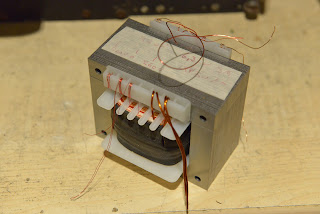Constructing a new transformer
With homebrew valve receivers it is always a problem to find a transformer for the power supply.
In the early days you could go to a vendor and buy them.
If you find a vendor then you have to pay sometimes a lot off money.
That's the main reason I decided to construct them myself.
This makes it a lot cheaper instead off buying them.
So I build a small windingmachine to make construction easy.
Have you ever considered constructing a transformer yourself?
It is possible to do it yourself by hand, it needs some practice but it is not impossible.
WARNING!!!
THIS TRANSFORMER WORKS WITH HIGH VOLTAGES AND CAN INJURE YOU, OR EVEN KILL YOU!!!
IF YOU DEICIDE TO CONSTRUCT ONE YOURSELF, YOU DO THIS AT YOUR OWN RISK!!
This is the formule:
Everything in centimeters.
Width middle leg X stacking height = Q
Q is multiplyed with 0,9 because by old transformers have sometimes paper between the metalsheets and the newtransformers lacquer.
Q X 0,9= Q effective
45 / Q effective = windings per volt.
Example:
Width middle leg = 3.5 cm
Stacking = 4.5 cm
Q = 3.5 X 4.5 = 15.75cm2
Qeff = 0.9 X 15.75 = 14.17cm2
45 / 14.17 = 3.17 windings per volt
45 makes the transformer core load safe, you could lower this, but will put more strain on the core.
220 V X 3.17 = 698 windings primairy
250 V X 3.17 = 793 windings secondairy
6.3 V X 3.17 = 20 windings secondairy
Surface winding window X Q effective = power from the iron core in watts.
It is necessary that the iron core power can cope with it(saturation), so it must be large enough.
1.7cm X 5,2cm = 8,84 X 14,17 Qeff = 125 watts for the core.
85X125/100 = 106.25 watts eff, max from core.
This means the core is to large for the Example.
Example: we have secondairy 250 volt 80 mA and secondairy 6.3 volt 2 Amp.
Ohms law = 250 X 0.08 = 20 watts secondairy
6.3 X 2 = 12.6 watts secondairy
In total 32.6 watts
The efficiency output performance will never be 1 to 1.
Because off losses in the iron core.
For a new transformer is the efficiency 85%.
For a old or damaged transformer is the efficiency 75%.
We have to send more power in then we get out, 100X32.6/85 = 38.4 watts.
Or 100X 32.6 /75 = 43 watts.
38.4 / 220volt = 175 mA primairy.
43 / 220volt = 195 mA primairy.
The thickness off the wire depens on the current draw.
On the internet you will find a tabel what gauge wire you can use.
So if you have a damaged transformer you can easely rewind it with succes.
Take care when you pull out the plates one by one and stack them carefully in order they come out.
This is important to keep efficiency as high as possible.
Core used is 50 watts.
220 volts in.
Push/pull 260 volts 70 mA out.
6,3 volt 3Amp 12 volts 0,5 Amp out.
Total 43 watts out.
Core watts Effective 50,5 watts drawn.
You can try it, it's great fun.
Primary voltage.
As you can see the voltage is higher!
So the secondary will also be higher.
Secondary 1.
But what would it be at the 220 volts?
286/234 = 1.2 x 220 = 264 volts.(Peak)
Secondary 2
Secondary 3
6.9/234 = 0,029 X 220 = 6,38 volts
Secondary 4
13/234 = 0.055X220 = 12,22 volts
In practical terms, the higher voltage on the primary doesn't present a problem for its use.
The transformer will be absolutely fine to use in the radio where he is designed for.
When you are about to start a new transformer,check the voltage on the net.
This also applies to net voltages from 120 volts, the primary gauges wire will be thicker then as it is by 235volts.
Your calculations will be correct.
Abonneren op:
Reacties (Atom)









